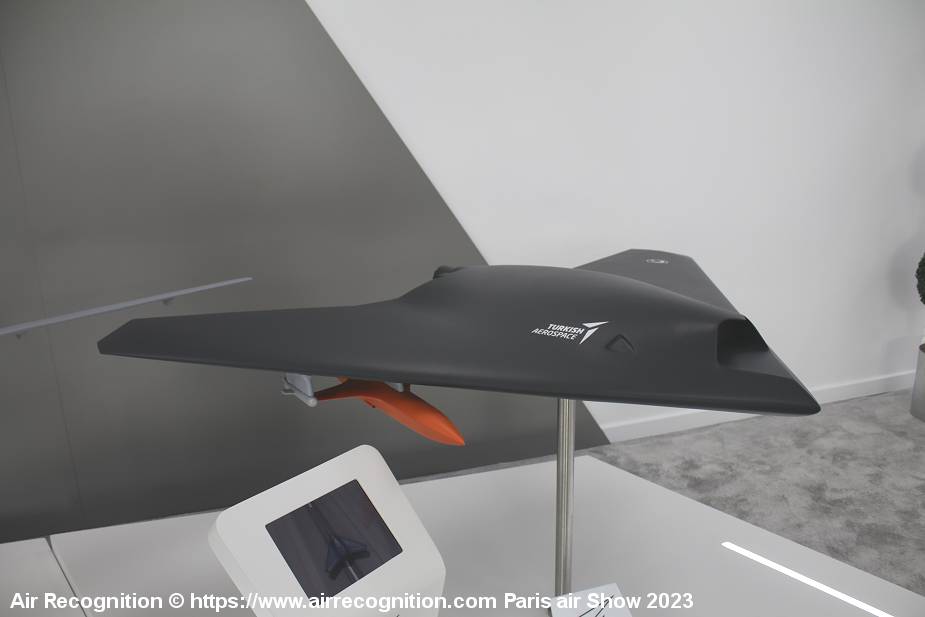The Paris Air Show 2023 provided an opportunity for the Army Recognition Group to gather crucial insights into the forthcoming advancements within the aerospace industry. Among the notable revelations, a representative from the Turkish Aerospace Industries (TAI) made an important announcement: in a mere two weeks, they are set to carry out the inaugural flight test of their state-of-the-art unmanned aerial vehicle (UAV) known as the ANKA-3 MİUS (Medium Altitude Long Endurance Unmanned Aerial Vehicle System). This disclosure highlights the significance of TAI's innovative efforts in pushing the boundaries of UAV technology.
Follow Air Recognition on Google News at this link
 TAI displays a scale model of the Anka-3 MALE UAV at the Paris Air Show 2023. (Picture source Air Recognition )
TAI displays a scale model of the Anka-3 MALE UAV at the Paris Air Show 2023. (Picture source Air Recognition )
The ANKA-3 MİUS drone represents the latest advancement in Turkey's UAV technology and is expected to play a pivotal role in various military operations. Developed by TAI, this combat drone boasts a delta-wing design, which offers exceptional aerodynamic performance and flight stability.
The forthcoming flight test will serve as a crucial milestone in evaluating the ANKA-3 MİUS's capabilities, ensuring its readiness for deployment in real-world scenarios. This trial run will allow engineers and technicians to assess its flight characteristics, propulsion systems, sensor capabilities, and overall performance under realistic conditions.
With its medium altitude and long endurance capabilities, the ANKA-3 MİUS is anticipated to fulfill a wide range of military requirements, including reconnaissance missions, surveillance operations, and combat engagements. Equipped with advanced technologies and an efficient jet-powered engine, this UAV demonstrates Turkey's dedication to enhancing its defense capabilities.
As the test date approaches, anticipation builds among defense enthusiasts, military experts, and industry observers eager to witness the ANKA-3 MİUS in action. The outcome of this flight test will provide valuable insights into the drone's potential and may influence future military strategies and investment decisions.
The Turkish Aerospace Industries, known for its expertise in developing cutting-edge aircraft and defense systems, remains committed to pushing the boundaries of innovation. The ANKA-3 MİUS represents another significant milestone in their pursuit of technological excellence, further solidifying Turkey's position as a key player in the global aerospace industry.
The successful execution of the first flight test will mark a remarkable achievement for TAI, bolstering their reputation as a leading manufacturer of unmanned aerial vehicles. Moreover, it will showcase Turkey's determination to strengthen its defense industry and reinforce its self-reliance in meeting national security requirements.
As the aviation community eagerly awaits the upcoming fly test, all eyes will be on the ANKA-3 MİUS, poised to take flight and demonstrate its remarkable capabilities.
The ANKA-3 MİUS (Medium Altitude Long Endurance Unmanned Aerial Vehicle System) represents the latest advancement in unmanned aerial vehicle (UAV) technology developed by Turkish Aerospace Industries (TAI). It shares its avionics architecture and Ground Control Station (GCS) with the ANKA and ANKA II UAVs.
One of the notable features of the ANKA-3 MİUS is its low radar visibility, providing stealth characteristics that enhance its ability to operate undetected. It also possesses high-speed transit capability, allowing it to swiftly maneuver through various operational environments.
The drone exhibits a high payload capacity, capable of carrying up to 1,200 kg (2,646 lbs) of equipment, weapons, or surveillance systems. This substantial payload capability enables it to fulfill a wide range of mission requirements.
The ANKA-3 MİUS is equipped with line-of-sight and beyond line-of-sight (LOS/BLOS) communication capabilities, which are achieved through satellite control. This feature ensures reliable and efficient communication between the drone and its ground-based operators, even when operating over long distances.
In terms of specifications, the ANKA-3 MİUS has a maximum takeoff weight of 6,500 kg (14,330 lbs). It boasts a service ceiling of 40,000 ft (12,192 m), allowing it to operate at high altitudes for extended periods. The drone has an impressive endurance of 10 hours at 30,000 ft (9,144 m) and 30 knots (34.5 mph).
When it comes to speed, the ANKA-3 MİUS has a cruise speed of 250 knots (287 mph) or 0.42 Mach at 30,000 ft (9,144 m). It can reach a maximum speed of 425 knots (489 mph) or 0.7 Mach at the same altitude.
















